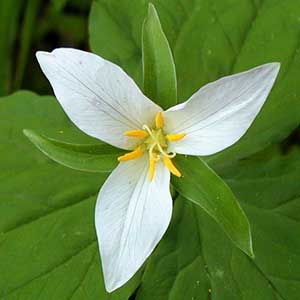Trillium sessile
Trillium ovatum
sessile trillium, sessile-flower wake-robin, toad trillium, toadshade
Pacific trillium, trillium, western trillium, western wake-robin, western white trillium, white or western trillium, white trillium
horizontal, brownish, thick, praemorse, fleshy.
semierect to horizontal, short, stout, praemorse.
1–3, round in cross section, 0.8–2.5 dm, slender to stout, glabrous.
1–2, round, 2–5 dm, ± slender, glabrous.
held well above ground, sessile;
blade green to bluish green, strongly to sparsely mottled, mottling becoming obscure with age, oval to suborbicular, 4–10 × 2–8 cm, base broadly attached, apex rounded-acuminate to bluntly parallel sided-acuminate (rounded basally to its broad attachment).
sessile, subsessile, or short-petiolate;
blade medium green, sometimes blotched and mottled, main veins prominent, ovate-rhombic, 7–12 × 5–20 cm, continuing to expand during anthesis, base rounded, apex acuminate.
erect, odor pungent, spicy;
sepals displayed above bracts, spreading, green, variously streaked with maroon, lanceolate-oblanceolate, 9–35 × 4–8 mm, margins entire, apex rounded-acuminate;
petals long-lasting, erect, ± connivent, ± concealing stamens and ovary, maroon, brownish maroon, green, or yellowish green, not spirally twisted, oblanceolate to elliptic, occasionally almost orbicular, 1.7–3.5 × 0.7–2 cm, thick-textured, narrowed near basal attachment (but not truly clawed), margins entire, apex gradually rounded-tapered to acute;
stamens straight, 10–23 mm;
filaments red-purple, 2–5 mm, dilated basally;
anthers erect, straight, gray-purple, 9–16 mm, thick, dehiscence introrse;
connectives purplish brown, straight, projecting 2–5+ mm beyond anther sacs;
ovary greenish white basally, purple distally, ovoid to globose, 6-angled, pyramidally narrowed to stigmas, 4–8.5 mm;
stigmas erect, divergent-recurved, distinct, purple, subulate, 1–5 mm, ± fleshy.
erect or nodding, odorless;
sepals spreading to horizontal, green, lanceolate to oblong-lanceolate, 15–50 × 6–20 mm, margins entire, apex acute;
petals erect-ascending, usually wide-spreading from base, exposing entire pistil, white or with pink or blush markings, lacking V-shaped markings, fading to rosy pink, purple, or dark red, veins not deeply engraved, ± linear to widely obovate, 1.5–7 ×1–4 cm, widest at or above middle, thin-textured, margins flat to undulate, apex acuminate;
stamens prominent, slightly recurved-spreading to straight, 10–18 mm;
filaments white, shorter than anthers, slender;
anthers yellow, 4–16 mm, slender, dehiscence latrorse-introrse;
ovary green or white, ovoid, 6-angled, 5–12 mm, attachment ± 3/4 ovary width;
stigmas recurved, barely connate basally, greenish white or white, linear, not lobed adaxially, 6–10 mm, uniformly thin;
pedicel erect to leaning, 2–6 cm.
baccate, dark greenish purple, odorless, subglobose, 6-angled, angles somewhat winglike, pulpy, not juicy.
baccate, green or white, ± odorless, broadly ovoid, obscurely winged, 1.2–2.8 × 0.7–1.9 cm, pulpy-moist.
= 10.
= 10.
Trillium sessile
Trillium ovatum
Trillium sessile is rather uniform throughout its range, with few color forms.
(Discussion copyrighted by Flora of North America; reprinted with permission.)
Varieties 2 (2 in the flora).
(Discussion copyrighted by Flora of North America; reprinted with permission.)
1. Bracts sessile; petals lanceolate to obovate, 1.5–7 × 1–4 cm | var. ovatum |
1. Bracts distinctly short-petiolate; petals linear to linear-lanceolate, 0.5–2.4 × 0.2–0.6 cm | var. oettingeri |
- Local floras:
BC,
CA,
OR,
WA
- Local Web sites:
CalFlora,
CalPhotos,
Flora NW,
PNW Herbaria,
Turner Photog.
WildflowerSearch
iNaturalist (observations)
USDA Plants Database
- LBJ Wildflower Center
- SEINet
- Plants of the World Online
- Encyclopedia of Life
- Wikipedia
- Google Image Search


